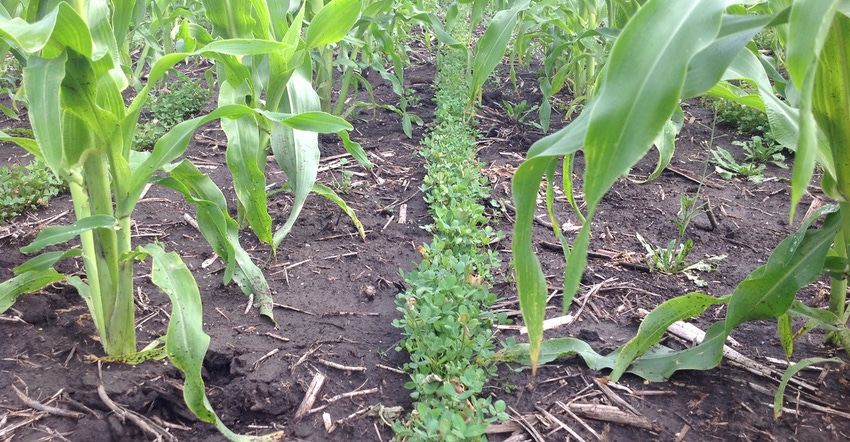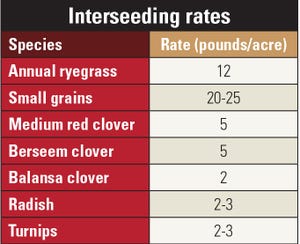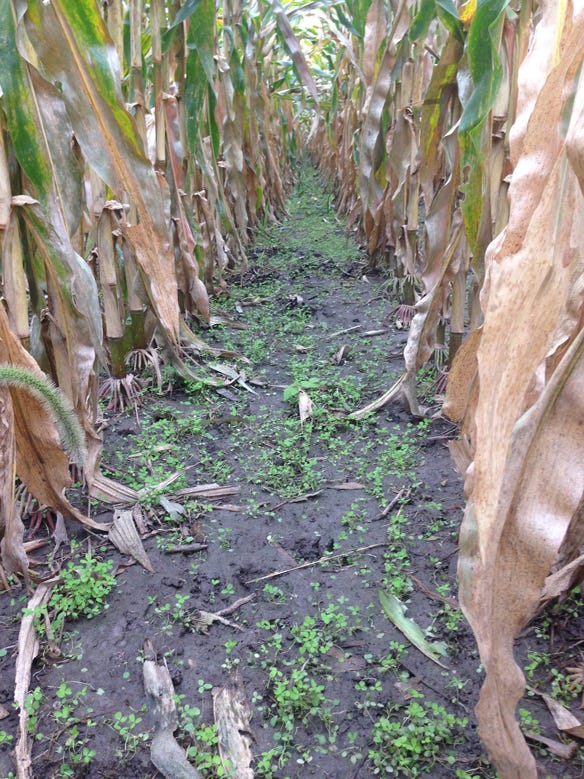May 1, 2019

By Brent Jones
To get a head start on establishing winter covers, interseeding has started to become a popular practice for producers in the northern region of the Corn Belt. Quite a bit of experimentation has been done over the last few years by farmers and researchers trying to dial in which species work best, when to plant, how to plant and which herbicides to avoid.
Along with early establishment, the benefits of a diverse plant population can be cashed in on by producers throughout the country. If done correctly, and with the right cover crop varieties, interseeding can significantly increase grain yields, reduce synthetic fertilizer requirements and improve soil health.
In a 2015-16 trial conducted at Ohio State University by researcher Ryan Haden, interseeding cover crops into corn improved grain yield up to 12 bushels per acre compared to a corn monoculture. Radish, annual ryegrass, Fixation balansa clover and red clover were included in the trial; all contributed to notable grain yield and biomass increases.
A high-clearance drill was used to interseed cover crops into corn at the V6 growth stage, in three rows spaced 7.5 inches between 30-inch corn rows. The corn was a glyphosate-resistant variety planted at a population of 32,000 plants per acre on March 21. Glyphosate was sprayed to control weeds one day prior to interseeding. Grain yields at harvest were measured based on a 15.5% moisture content for corn grain. Cover crop biomass (reported on a dry weight basis) was measured in late November prior to the first killing frost, and in mid-April just prior to termination with herbicide.
Putting it into practice
Fields without a lot of weed issues are best for interseeding cover crops to avoid problems caused by herbicide residuals. After a spring burndown with glyphosate and 2,4-D, residuals will have to be avoided to get the cover crop established. If weeds will be a problem without a residual, then the chance of success is low.
The earlier a cover crop can be 
Seeding should be done with a drill between the corn rows for best establishment. Broadcasting can work, but you’re depending on rain to get the seed worked into the soil. Depending on the species, seed rates may need to be set back by as much as 50%.
Varieties matter
Depending on your soil type, climate and goals, there are multiple species of cover crops that can be successfully established into standing corn.
Legumes like red clover, cowpeas, crimson clover, berseem clover and balansa clover can fix atmospheric nitrogen to help feed the corn plants. Flowering plants like buckwheat and phacelia bring in beneficial insects to help keep harmful ones in check. Grasses with deep, fibrous roots add carbon to the soil and help with water infiltration and retention

VARIETIES IMPORTANT: Selecting cover crop species based on variety traits is essential to successful establishment when interseeding. Varieties must grow quickly and establish extensive root systems to sustain themselves when the corn canopy closes in July and August.

However, because plants will go dormant in July and August when the corn canopy is closed, species must grow quickly, possess shade tolerance and have an extensive root system to sustain themselves until the canopy opens at harvest. It is essential to choose cover crops based on variety traits, rather than buying variety-not-stated (VNS) seed. Traits like maturity and cold tolerance are important and will allow you to reach your goals.
For example, in the OSU interseeding trial, Fixation balansa clover contributed to the greatest grain yield increase by an additional 12 bushels per acre, and it was second in biomass measurements.
Because it has been bred specifically to fix significant amounts of nitrogen from the environment into soil, the companion and subsequent crops can cash in on hundreds of pounds of free nitrogen. The variety has also been bred for cold tolerance, surviving in subfreezing temperatures at minus 20 degrees F with no snow cover. However, if VNS balansa clover seed was used instead, yield, nitrogen fixation, biomass and persistence could be inconsistent field to field, and may not respond well to the environment, as noted in the chart below.

Power of plant diversity
Perhaps the biggest benefit cover crops can bring to a cornfield is soil rejuvenation. Extensive root systems required to survive summer dormancy will loosen compaction while burrowing deep into soil. A diverse mix of plants will also work together to form an underground network of fungal pathways and microorganisms that transfer and share vital plant nutrients like nitrogen, phosphorus, manganese and sulfur.
While there are multiple species and multiple ways to interseed cover crops into corn, they all require careful and early planning for successful establishment.
What works on one farm may not always work on another, so small-scale experimental trials are the best way to get started. If you have questions about how to incorporate interseeding into your crop system,call Grassland Oregon at 503-566 9900.
Jones is the Iowa research farm manager for Grassland Oregon, a forage application company.
Source: Grassland Oregon, which is solely responsible for the information provided and is wholly owned by the source. Informa Business Media and all its subsidiaries are not responsible for any of the content contained in this information asset.
You May Also Like




